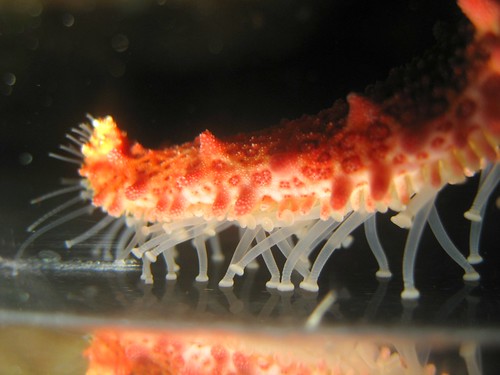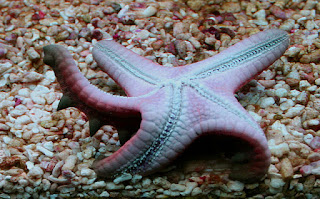Hi
all! Today, we will share some bio-inspirations of starfish!
Ossicals: resist fractures via microscopic holes
in the structure
'Foamy' materials
in which any threatening crack will be in short order run into a hole. This
reduces the chance of cracking. The little hard bits of echinoderms, the
ossicles, develop as single crystals, but they avoid excessive brittleness of
typical crystals by being especially holey.
Bioinspired products/applications:
Construction, ceramics, material science,
building science, pipes
·
Concrete
& building materials for construction,
·
Packaging
materials (save more energy during recycling),
·
Plastics
e.g. computer case (prevent cracks from spreading),
·
Pipes
('self-arrest' any cracks)
Source: 1) Vogel S. 2003. Comparative
Biomechanics: Life's Physical World. Princeton: Princeton University Press. 580
p.
Tube
feet: move & handle
food using hydraulic system
Something similar
happens in echinoderm tube feet-small, soft, unjointed and exceedingly numerous
organs used for locomotion and handling food which are noticeable when a
starfish creeps up the glass wall of an aquarium. Ampilla, which available
above each tube foot is a bulbous chamber that is equipped with circular
muscles and reinforcing fibers at right angle to that muscle. The contraction
of foot muscle forces the expelled fluid into the ampulla by extending its
muscle. That couples the food muscle and ampulla in a hydraulically linked
antagonism (McCurley and Kier 1995). The whole thing hooks onto the
water-vascular system of pipes to vary the overall volume. A one-way flap valve
prevents contraction of either foot or ampullary muscle from forcing water back
into the pipes at the same time (Maerkel and Roesel 1992).
Bioinspired products/applications:
Safety mechanisms for pipes, water
supply & sanitation, oil and gas
Source: 1) Vogel S. 2003. Comparative
Biomechanics: Life's Physical World. Princeton: Princeton University Press. 580
p.
2) McCurley, RS; Kier, WM. 1995. The functional
biology of starfish tube feet: the role of a crossed-fiber helical array in
movement. The Biological Bulletin. 188(2): 197-209
3) Maerkel, K; Roeser, U. 1992. Functional anatomy of
the valves in the ambulacral system of sea urchins (Echinodermata: Echinoidea).
Zoomorphology. 111: 179-192.
Body:
helps buffer thermal variations in low tide by taking up and storing cold sea
water during high tide
Scientists have discovered that starfish
has remarkable strategy to avoid overheating in the sun. It pumps itself up
with cold seawater to lower the body temperature when being exposed to the sun
at low tide. It is equivalent to a person drinking 7 L of water before heading
into the midday sun (Bourton 2009). The body temperature of ectotherms is
influenced by the interaction of abiotic conditions, morphology and behaviour.
Organisms living in different thermal habitats may exhibit morphological
plasticity or move from unfavourable locations.
When starfish exposed to high body temperature at low tide, it increases the
amount of colder-than-air fluid in their coelomic cavity when submerged during
high tide, resulting in a lower body temperature during the subsequent high
tide. The enables them to modify the coelomic fluid volume which provides them
with a novel thermoregulatory 'backup' during prolonged exposure to elevated
aerial temperatures (Pincebourde et al. 2009).
Bioinspired
products/applications:
Electronics, Computer science, Building,
Construction, Manufacturing
·
Buffer
temperature fluctuations in buildings
·
Computer
equipment by adding a fluid
Source: 1) BourtonJ. 2009.
Starfish 'pump up' to cool down. BBC Earth News
2) Pincebourde S; Sanford E; Helmult B.
2009. An intertidal sea star adjusts thermal inertia to avoid extreme body
temperatures. American Naturalist. 174(6): 890-7.
Legs & tubes: allow movement and feeding by hydrostatic pressure
The echinoderms bodies work
by unique exploitation of hydrostatic principles. Each thin tube of the feet
ending in a sucker is being kept firm by the pressure of water within the waves
and curl in rows along the arms. When a drifting particle of food touches an
arm, tube feet fasten onto it and pass it on from one to another until it
reaches the gutter that runs down the upper surface of the arm to the mouth at
the centre (Attenborough 1979:49).
Bioinspired
products/applications:
Prosthetic limbs, robotics,
transportation or other movement using water pressure, manufacturing,
medical, transportation industries
Source: 1) Attenborough,
David. 1979. Life on Earth. Boston, MA: Little, Brown and Company. 319 p.
Arms: self-repair / self-healing
Self-healing solves the
quality assurance problem and reduces life cycle costs. The extended life
reduces the number of replacements as well as future costs. This self-repairing
materials is less expensive because the repair material is built in and high
availability.
Bioinspired
products/applications:
Self-repairing concrete
·
consists of
repair material in hollow fibers in the repair matrix before it is subjected to
damage; the usual approaches for structural concrete repair are polymer
injection, pre-stressing, geomembranes and polymer wraps where these techniques
are ductile, less brittle failure and unstable.
Polymer composites
·
With unique
toughness and strength by self-repair which occurs at material interfaces and
damaged areas. It is repaired by releasing repair chemicals from within the
composites itself. The hollow fibers are embedded in the matrix and the
chemicals are released whenever there is cracking or other matrix damage
occurs. The crack faces are rebounded when the repair chemical flows into the
crack.
Source: 1) The Natural
Process Design, Inc.
That's
all for today! Till next time! =)









